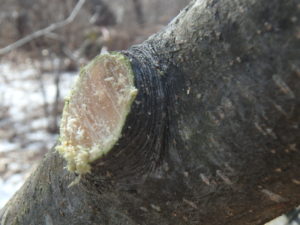Fall Pruning: Who, What, Where and How?
If you have cut back your perennials, cleaned up the vegetable garden and raked the leaves, you have good reason to be a tad smug. You’re ahead of me. But don’t be too proud – there is still plenty to do outside. It’s time for some fall pruning.
First you need to know who gets a haircut, and who does not. Let me preface this by saying that, with a few exceptions, you can prune anything at any time and not hurt the plant. Yes, you will reduce bloom count if you prune spring bloomers now. And maples and birch will bleed like crazy if you prune them when the sap is running. But you can prune anything now, in the spring, or in August without damaging your plants.
Plants that already have their flower buds will bloom earlier than those like hydrangeas or fall blooming clematis that bloom later on new growth. Early bloomers include forsythia, lilac, magnolia, fothergilla, viburnums, rhododendrons and azaleas. Right now you can see big fat buds on most of those – just waiting for spring and the right time to bloom. Yes, you can prune them now, but you lose flowers later on. So you may want to just do a little pruning on these, and wait to do heavier pruning after they bloom in the spring.
Hardwood trees like maples, beech, oak, magnolia and linden can be pruned now. Roses I usually prune in the spring, after I see how much the winter has killed off, if anything. Evergreens like pine and hemlock I usually prune right after the new growth has occurred in summer.
Fruit trees are traditionally pruned in late winter or early spring, but you can prune apples and other fruits now, and I often do. There is no snow to wade through the way there often is in March. For home gardeners losing a few blossoms – and hence some apples – really is not a loss. In a good year I grow many more apples than I can eat, store, or process. I want my trees to be handsome all winter, not cluttered with too many branches. I want my trees to be sculpture on the landscape.
Don’t be a timid pruner. A few bold cuts (removing large stems) can transform a tree in just a few minutes. Nibbling away at the edges, taking off pencil-thick branches is slow, tedious work.
How much wood can you remove in a single season? The old rule of thumb was a third of the leaf-producing branches. Now experts advise just 20 to 25%. Remember, the leaves are the engine of the tree. They produce the sugars that feed the roots and produce the fruit.If you cut off too many branches (with their leaves), your tree may respond by producing lots of new growth next year in the form of water sprouts or suckers you don’t want.
Aside from the beauty of a well-pruned tree, pruning should open up the canopy so that sunshine can get to every leaf. If a shrub is too crowded with branches, the interior of the tree is a mess, and many leaves do not benefit from the sun. I like to say that a bird should be able to fly through a well-pruned apple tree without getting hurt.
Where should you make your cuts? At the origin of the branch, either on a bigger branch, the trunk, or at ground level. Don’t cut off a branch flush to the trunk as it will open up a big wound. Instead, look at the branch and see where the “branch collar” is, and cut just beyond it. The collar is slightly swollen area at the base of a branch, and its bark is often wrinkled.
My late sister, Ruth Anne, loved to prune. She always started pruning by sitting on the ground near the base of a shrub and looking up through the branches. She would decide which bigger branches should be removed, and cut them off near the soil surface.
Or start by taking out any dead branches first. Dead branches have dry, flakey bark. If you rub the bark of a small branch, you should see a green layer. Dead branches don’t count when you are calculating how many branches you can remove.
Here are the cuts I make when pruning a tree, in the order I take them out: 1. Dead wood. 2. Damaged or cracked limbs. 3. Crossing or rubbing branches. 4. Branches that are growing toward others, or toward the center of the tree. 5. Branches that are paralleling others. I remove the weaker of the two.
I recently gave my common ninebark (Physocarpus opulifolius) ‘Diablo’ a heavy pruning, even though it means I won’t see many flowers in the spring. It was just so big and messy, it was driving me crazy. I cut a few large stems right out, and a few others I removed half way down. The shrub is much less cluttered, and considerably shorter. It will look good with a dusting of snow – which is one the way.
So get out there and do some fall pruning. Your trees and shrubs will look better all winter, and healthier next summer.
Henry gardens in Cornish Flat, NH. You can reach him at henry.homeyer@comcast.net. He is the author of 4 gardening books, and blogs regularly at www.dailyuv.com.





